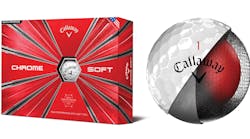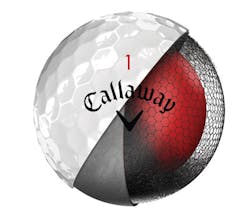Engineers at the Callaway Golf Co. redesigned the golf ball by using graphene as part of the ball’s outer cover. The material consists of an ultra-thin (one-atom thick) layer of hexagonal carbon that is 150 times as strong as steel on a per-pound basis, and can be stretched to up to 120% of its length without breaking or deforming. The carbon hexagons apparently flex easily but do not break.
As part of the outer layer, graphene lets the inner core be larger and softer, explains Alan Hocknell, VP of R&D at Callaway. The outer layer also contains a firmer blend of poly butadiene. The larger, softer core on Callaway’s new Chrome Soft and Chrome Soft X balls (about $45 per dozen) lets golfers hit the ball farther using drivers or irons, and gives them more control over spin on the ball which can make the ball stop and roll back (usually towards the hole) on the green. The graphene converts more of the power in the swing to distance, which might be more evident in golfers who can swing the club head at over 105 mph, says Hocknell.
According to Callaway’s studies, the softer the golf ball, the more forgiving it is, which means it will tend to go straight and maintain speed even if you don’t hit the ball with the center of the club face.
Both Chrome Soft (shown) and Chrome Soft X from Callaway use graphene on the inner layer.
The balls also have a softer urethane cover. It effectively grips the graphite-enhanced harder outer cover when the ball is struck, creating more spin and letting the golfer better control it. Urethane is also odd in that it becomes more durable the softer it gets, so the balls not only spin more on the green and go further on drives, but last longer.
However, the ball has caused concern for PGA officials and fans who think it is a gamechanger, one in a parade of technological advances in clubs and balls that have greatly improved the game of professionals. For example, 43 pro players on the PGA tour average more than 300 yards on their drives last season. And one player, Dustin Johnson, came within 6 in. of a hole-on-one a 433-yard hole.
Some fans believe the new ball and other high-tech goodies will lead to longer holes, larger golf courses, and more time spent walking from one end of the course to the other. Even Hocknell admits that the scientific progress in ball development might lead to different rules for professionals and amateurs.



